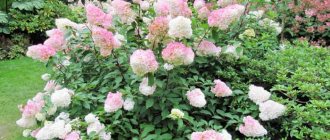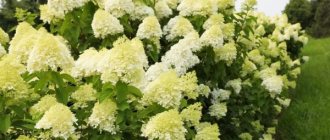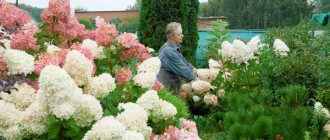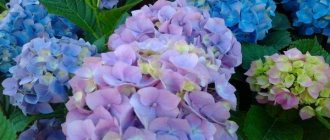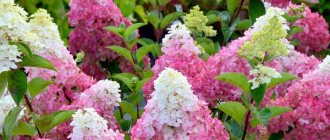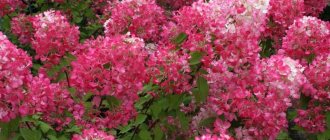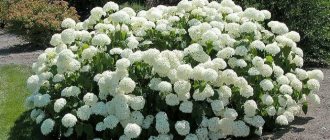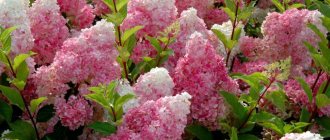Author: Elena N. https://floristics.info/ru/index.php?option=com_contact&view=contact&id=19 Category: Garden plants Published: February 21, 2019Last edits: January 13, 2021
- Hydrangea paniculata Grandiflora (large-flowered)
Hydrangea paniculata (lat. Hydrangea paniculata) is a species of the genus Hydrangea of the Hydrangeaceae family, common in nature in Japan, China and the south of Sakhalin. This attractive and fast-growing crop is widely used in landscape design.
Planting and caring for paniculata hydrangea
- Flowering: from mid-June to October from four to five years of age.
- Planting: in the spring before the buds swell or during leaf fall.
- Lighting: bright light or partial shade.
- Soil: fertile, neutral, without any admixture of lime or other alkalis, clay soils or red soil are preferred.
- Watering: abundant and regular: the soil in the tree trunk circle should be moist all the time.
- Fertilizers: fertilizers are applied 4 times per season: in early spring - organic matter with a high nitrogen content, during budding and in mid-summer - full mineral fertilizer, and in autumn - potassium-phosphorus fertilizer.
- Pruning: sanitary and formative pruning, and, if necessary, rejuvenating pruning is carried out at the end of March.
- Reproduction: most often by layering and cuttings.
- Pests: aphids, spider mites, root-knot nematodes, snails.
- Diseases: white and gray rot, powdery mildew, peronospora, septoria, chlorosis, ring spot virus.
Read more about growing paniculata hydrangea below.
Plant characteristics
Hydrangea (Hydrangea) is a type of plant, usually a dense tall shrub, the main decoration of which is beautiful, long-flowering inflorescences. More often grown in gardens, large-leaved hydrangea or macrophylla (Hydrangea macrophylla). Its magnificent, variegated, spherical and usually very large inflorescences are proudly presented in many garden plots, allotments, parklands, and among city greenery.
Playing second fiddle is the panicle species (Hydrangea paniculata). Plants vary in size and color of inflorescences depending on the variety.
This species is worth paying attention not only because of the magnificent, impressive inflorescences, but also because of the high frost resistance of this plant, which predisposes it to grow in our climate. From the point of view of frost resistance, most paniculate varieties are successfully grown in the Moscow region and central Russia; some varieties grow successfully even in Siberia and the Urals.
The main difference between paniculate and large-leaved hydrangeas that is striking is the shape of the inflorescences. In large-leaved hydrangeas they are spherical or slightly flattened, while in paniculate hydrangeas they take the shape of a cone.
In the paniculate species, the inflorescences (depending on the variety) are creamy-white, pink-white, 15-20 cm in size, appear from the second half of summer to autumn (August-September) and, therefore, much later than macrophile flowers.
Drawing. Paniculate and large-leaved hydrangeas - differences in inflorescences
Paniculate hydrangea (Hydrangea paniculata) belongs to a large genus, represented by 25 species, native to South and Southeast Asia, North and South America. The shrub has very attractive flowers, collected in luxurious inflorescences. Hydrangea flowers are very decorative thanks to their colorful cup-shaped petals.
The plant forms tall bushes reaching a height of 2.5 meters; there are individual specimens reaching a height of 4 meters. The flowers are predominantly creamy-white (pink-red during flowering), collected in large conical inflorescences. Recently, varieties with flowers in shades of pink have been developed.
The shrubs bloom from July to September. Over time, the blooming inflorescences become more decorative. The advantage of the paniculate type of hydrangea is that it blooms on shoots formed in the year of flowering. Thanks to this, it is not subject to freezing, as happens in the case of large-leaved hydrangea.
The paniculate type of hydrangea grows best in sunny or partial shade. It is resistant to low temperatures. Overwinters without shelter in most areas. In cool regions, winter protection is required by erecting mounds to protect the bulk of the shoots from freezing. Embankments are made from:
- bark,
- sawdust,
- humus.
Botanical description
Hydrangea paniculata is a shrub or tree up to 10 m high with shallow roots, the distribution area of which significantly exceeds the projection of the crown. The leaves of Hydrangea paniculata are ovoid or elliptical, up to 12 cm long. Honey-bearing inflorescences are densely hairy, wide-pyramidal panicles up to 25 cm long and consist of large sterile flowers with a diameter of up to 2.5 cm, the greenish-white petals of which gradually turn pink, and small fertile white flowers with early falling petals. Hydrangea paniculata blooms for the first time at the age of 4-5 years. The fruit is a capsule that cracks at the top when ripe and contains numerous small but extremely viable seeds.
Red hydrangeas with photos and names
The luxurious red coloring of the petals attracts attention . Many gardeners choose the following varieties of hydrangea with red petals:
- vanilla fraise;
- Wims red;
- Diamond Rouge Rendia;
- strawberry dessert (Hydrangea paniculata vanilla strawberry);
- Samara lidiya (Samarskaya lidiya);
- Magical Vesuvio;
- Magical fire;
- Fraise melba.
Planting paniculate hydrangea in open ground
When to plant
The best planting material is four to five year old seedlings that take root well and can bloom within the year of planting. Hydrangea paniculata is planted in the spring, before the sap begins to flow, or during leaf fall. Seedlings planted in the spring will almost certainly bloom soon, but if planting is carried out in the fall, it is necessary to insulate the tree trunk for the winter.
Hydrangea paniculata can grow in partial shade, but in bright sun its flowering will be longer and more lush. It is very important that the plant is protected from strong cold winds.
- Roses (bush): planting, care, propagation
Growing hydrangea in the garden - planting and care
Hydrangea paniculata prefers soil that is fertile, neutral, without any traces of lime or other alkaline compounds, due to which it may, at best, bloom poorly, and at worst, simply die. Keep in mind that the plant's roots extend far from the trunk, so do not add chalk, dolomite flour or ash to the soil within a diameter of 5-6 m from the intended planting site. Do not plant bulbous flowers in this space that require annual digging of the soil - tulips, gladioli, hyacinths. Brown peat, pine soil or sawdust can be added to acidic soil to neutralize it. Hydrangea paniculata grows poorly in sandy soil.
How to plant
The landing site is prepared in advance. The pit for paniculata hydrangea should be spacious: depending on the size of the seedling, from 50x50 to 80x80 cm with a depth of 40 to 60 cm. The distance between two hydrangeas or between the hydrangea and other plants should be 2.5-3 m. Fill the hole with 2- 3 buckets of water so that the moisture saturates the ground well. The next day, fill the hole almost to the top with a mixture of fertile soil, sand, peat and humus (2: 1: 2: 1), adding 25 g of urea and potassium sulfate and 65 g of superphosphate to it and mixing thoroughly. Allow the soil to settle and settle.
The roots of seedlings are slightly pruned before planting, and in tree-like forms of paniculata hydrangea, annual shoots are also shortened, leaving no more than 3-5 buds on them. Only large-leaved hydrangea seedlings are not pruned, since the flower buds of this plant are located at the ends of the shoots.
Lower the root system of the seedling into the hole, straighten its roots and dig the plant so that the root collar is slightly above the surface of the area. Water the seedling well, and when the water is absorbed and the soil settles a little, the neck will be where it belongs - at the level of the surface of the site. Mulch the tree trunk of the seedling with pine needles, leaf humus or acidic peat and at first shade the plant from the bright sun.
Common Hydrangea Problems
There can be many problems with the development of a flower, the main one being the state of the soil or the environment: cold winter, freezing of the tops of branches and buds; early opening of hydrangea in spring and unexpected frosts; a variety that is not able to grow in the planting region due to unsuitable climate; low acidity of the earth; not enough liquid, poor and weak watering; heavy soil, poor air permeability; the plant is not fertilized, lack of nutrients, poor quality soil; the appearance of pests or diseases that inhibit plant growth; pruning was carried out without taking into account the rules, and the buds of the bush were cut off; hydrangea roots are damaged for various reasons.
Garden hydrangea
It is in spring that you can see the condition of the bush. If the plant wakes up with difficulty, does not produce new young branches, the buds bloom poorly, the inflorescences do not form, or there are few of them, small flowers, this indicates a problem that needs to be solved urgently.
Poor growth due to poor root system. When does paniculate hydrangea bloom, large-leaved and tree-like. It is the roots of the plant that carry the main information about the plant: if they are damaged, then the above-ground part will not feel well.
The main causes of damage to the root system are: frost; pests; diseases (fungal or infectious).
With a flower that grows at home, everything is simple: just take it out of the container along with a lump of earth and check the condition of the roots. It is best to clean the soil, carefully remove damaged and diseased parts, and rinse with clean water. Watering with a weak solution of potassium permanganate will have a good effect on the root system of an indoor flower. In specialized stores you can purchase a root strengthener that will help the plant.
Hydrangea did not wake up after wintering
Such a check is accompanied by further transplantation into new soil; a couple of weeks after this procedure, fertilizing should be carried out.
Important! When replanting, you should be as careful as possible with the roots of the plant and not damage healthy, strong roots; the procedure should be carried out with minimal losses.
Why is hydrangea slow to grow in the garden?
In this case, the condition of the roots is checked a little differently. It is necessary to remove the top layer of soil and check the visible part of the root system. If everything is fine, no diseases, pests or other damage are found, then you need to cover everything on top with fresh soil and feed it with fertilizer.
If problems are found, then the plant must be treated urgently so that it does not die completely. The easiest way is to dig up the bush and plant it in a new place in fresh soil.
Poor growth due to non-compliance with pruning rules. Hydrangea forms shoots on last year's shoots, which means that when pruning you should know exactly which branches can be trimmed and which cannot. If an inexperienced gardener does the pruning incorrectly, you may not see flowers for several years.
Caring for Hydrangea paniculata
Planting paniculata hydrangea and caring for it is not labor-intensive. Garden hydrangea paniculata can grow near highways and in other unfavorable places, but if you want to see it in its best shape, do not neglect to perform simple plant care measures.
Hydrangea paniculata, like other species of the genus, is extremely moisture-loving, so the soil in its trunk circle should be slightly moist all the time. Do not allow the soil to dry out on hot days. Water the plant once a week, pouring at least 3 buckets of water under each adult bush. It is good to add potassium permanganate to the water for irrigation from time to time. In order to retain moisture in the soil as long as possible, the tree trunk circle is regularly mulched with leaves or sawdust.
Hydrangea paniculata is fed four times a season. In early spring, at the very beginning of sap flow, organic matter is added to the soil - a solution of mullein or bird droppings, for example. The next feeding is carried out during the budding period: a solution of 35 g of potassium sulfate, 35 g of superphosphate and 25 g of urea in 10 liters of water is added to the tree trunk circle - this amount is enough to fertilize 1 m². In mid-summer, hydrangea is fertilized with a solution of 25-35 g of granular complex mineral fertilizer in a bucket of water. Consumption – 2-3 buckets per adult bush. The fourth feeding is applied when preparing the plant for winter: in this case, use a special fertilizer for hydrangeas that does not contain nitrogen.
To form an ideal bush or tree, proper pruning of hydrangea is very important, which is usually done at the end of March. When forming a bush, leave from 5 to 10 developed shoots and shorten them to 3-5 buds. The remaining shoots are cut to the base. Old hydrangea is subjected to anti-aging pruning, shortening all shoots to 6-7 cm from the surface of the ground: next year the old plant will produce young shoots.
Hydrangea paniculata, like any other plant, can suffer from diseases or pests. Most often, powdery mildew and aphids cause trouble for her. To get rid of powdery mildew, you need to treat the plant several times every 10-12 days with one percent Bordeaux mixture or a solution of 20-25 g of Fundazol in 10 liters of water. Ordinary garlic will help to cope with aphids: 250 g of crushed cloves are poured into a bucket of water, left for two days, after which 50 g of grated laundry soap are added to the infusion, dissolved, stirring, and the bush is treated, trying to ensure that the solution wets not only the top, but also underside of hydrangea leaves. Treatments with garlic infusion should be carried out once a week until the aphids disappear. If garlic does not cope with the task, you will have to resort to the help of acaricidal drugs - Akarin, Aktar or Actellik, for example.
With the onset of cold weather, paniculata hydrangea in Siberia and the Urals needs shelter. Sometimes you have to cover hydrangeas in the middle zone if weather forecasters predict a frosty and snowless winter. The root zone is covered with a layer of rotted manure, peat or dry leaves at least 20 cm thick. As soon as snow falls, throw a snowdrift under the bush or tree.
Diseases and pests
There are several causes of disease. If you grow hydrangeas, it is important to be able to determine from the symptoms what they are lacking.
Chlorosis
A very common condition is chlorosis. The leaves turn yellow, but the veins remain green. This happens due to lime in the soil, also due to a lack of iron. What to do: add 50 g of ammonium sulfate, every other day spray the leaves with iron chelate. Mulching with pine needles and acidic peat also helps.
Chlorosis
Leaf burns
Whitish spots that then become thinner and dry out. Indicate that the hydrangea is growing in an inappropriate, too sunny place. In paniculata they occur less often than in tree-like ones. If you replant the bush or provide shading, the burns will go away.
Leaf burns
White rot
The disease is of a fungal nature, very contagious, transmitted from one plant to another. If the spots have just appeared, you can try fungicidal preparations.
White rot
Gray rot
A fungus that appears due to dampness and if the plant does not have enough space. Damaged leaves need to be cut off and burned, then spray the hydrangeas with potassium permanganate.
Gray rot
Downy mildew
Oil spots appear on the leaves, then they turn gray. The recipe is the same - remove diseased leaves and treat the plant. A Bordeaux mixture or a solution of 15 g of copper sulfate and 150 g of soap per 10 liters of water is suitable. Powdery mildew begins with yellow-green spots, after which a dusty coating appears on the lower surface. After burning the affected leaves, treat the bush with fungicides (for example, Fitosporin-B). It cannot be processed next year, only after a year.
Downy mildew
Septoria
With septoria, the spots look like brown rings, light inside. They occur not only on leaves, but also on stems. All damaged areas must be cut off, also including healthy tissue, and the wounds must be treated with potassium permanganate. The entire bush can be treated with any product that contains copper (Bordeaux mixture, copper sulfate).
Septoria
Rust
Yellow areas, which then become raised and brown, from which dust falls - fungal spores. Remove the leaves and treat the hydrangea with copper chloride.
Rust
Parasitic insects can also cause a lot of trouble. You have to collect slugs by hand and destroy their clutches. Spider mites cause leaves to curl into tubes. To avoid resorting to insecticides, try a soap solution or mineral oil early on. You can plant marigolds next to the hydrangea. These flowers are loved by ladybugs, which eat aphids.
Parasitic insects
Reproduction
Most often, paniculata hydrangea is propagated by cuttings and layering. The remaining cuttings with 4-5 buds after spring pruning are placed for two days in a weak Kornevin solution, after which they are planted on a school bed, burying the lower cut in loose acidic soil for two buds. Cuttings of paniculata hydrangea must be protected from bright sun, and the soil in the garden bed should be regularly moistened, not allowing it to dry out. As soon as young leaves appear on the cuttings, the shading is gradually removed. For the winter, the cuttings must be covered with spruce branches. Next summer, it is better to remove the first flower stalks so that the plant can devote all its energy to growing the root system. Cuttings are planted in a permanent place at the age of 4-5 years.
It is very easy to propagate paniculate hydrangea by layering: in the spring, a low-growing shoot of a young plant is bent to the ground, pinned to it and the place of fixation is covered with fertile soil or peat. The cuttings are watered throughout the season, covered with spruce branches for the winter, and next spring they are separated from the mother plant and transplanted to a school bed for growing.
Low growing varieties
For small garden plots or to form a hedge separating outbuildings from the recreation area on the site, use dwarf varieties of paniculate hydrangea .
The most famous varieties are:
- bobo;
- bombshell;
- Cotton cream;
- Sundae fraise.
Varieties
We are sometimes asked to list the “names of paniculate hydrangeas”, the most popular in cultivation and at the same time the least capricious to care for, and are also asked to recommend varieties of paniculate hydrangea for the Moscow region. Actually, any variety of this species is winter-hardy enough for moderately frosty winters, but in conditions of abnormal cold, they all need shelter for the root zone.
- Which ground cover flower to choose
We offer you the best varieties of paniculata hydrangea.
Hydrangea paniculata Grandiflora (large-flowered)
A shrub that over time takes the form of a tree up to 3 m high. It is distinguished by later flowering than other varieties. Collected in wide pyramidal inflorescences up to 30 cm long, the large sterile flowers of this variety are creamy when blooming, pure white in full bloom, and then pinkish - becoming greenish-red closer to autumn. The lifespan of plants of this variety is about 30 years;
Hydrangea paniculata Vanilla Fraze
The plant is up to 150 cm high and has a crown of the same diameter. The inflorescences are large, similar to lilac clusters. The flowers are creamy at first, then they turn pink, and towards the end of flowering they become dark red. One bush can have snow-white and bright crimson flowers at the same time. Plants of this variety can withstand frosts down to -29 ºC;
Hydrangea paniculata Phantom
A plant up to 2 m high with a crown diameter of the same size. The inflorescences of this variety are large, dense, round-pyramidal. The flowers are light cream in color when opening, but become pinkish over time;
Hydrangea paniculata Pink Diamond
The inflorescences of this variety, up to 30 cm long, consist of creamy white flowers that gradually acquire a dark pink, almost red color;
Hydrangea paniculata Limelight
A plant extremely popular among designers due to its strong shoots that easily withstand heavy greenish inflorescences, which turn white in bright sun and pink towards the end of flowering. The leaves of this variety are green in spring and summer and turn purple in autumn;
Hydrangea paniculata Pink Lady
A fan-shaped shrub up to 2 m high with a spreading crown, straight brown shoots that acquire a reddish tint in autumn, and white inflorescences up to 30 cm long. Over time, a light blush appears on the fragrant white flowers, then the flowers gradually become soft pink;
Hydrangea paniculata Magical Candle
A plant with a spreading crown and large pyramidal inflorescences of light cream and green fragrant flowers, which turn pink in summer and crimson in autumn;
Hydrangea paniculata Vims Red
A plant with inflorescences up to 35 cm long, conical in shape, emitting a honey aroma. During the season, the flowers turn from white to pink, and at the end of flowering - deep red;
Hydrangea paniculata Diamond Rouge
A compact upright shrub with inflorescences up to 40 cm long, the flowers of which are initially white and then acquire a rich crimson-red color;
Hydrangea paniculata Sunday Fries
Dense compact bush with red-brown shoots, pubescent leaves along the veins and white flowers, which become lilac-pink by the end of summer;
Hydrangea paniculata Pinky Winky
A variety that was bred more than 10 years ago, but still has not lost its popularity. This is a small tree or bush with a wide-rounded crown and shoots that grow up to 30 cm annually. Powerful stems bear paniculate inflorescences of white flowers, which change color to pink-purple during the season;
Hydrangea paniculata Melba Fraze (Fraiz Melba)
A new variety, which is a tall bush with dark burgundy shoots with a brown tint and dense pyramidal inflorescences 45-55 cm long, consisting of milky white flowers, gradually acquiring at first a soft pink, and towards the end of flowering a rich wine-red hue.
In addition to those described, the following varieties of hydrangea paniculata are grown in culture: Silver Dollar, Little Lime, Kyushu, Bobo, Tardiva, Presox, Unique, Floribunda, Matilda, Darts Little Dot, Brussels Lace and others.
- Chistets: growing from seeds in the garden, types and varieties
The best varieties with photos and names of pink color
Pink color is no less popular. The most famous varieties with pink corollas:
- graffiti;
- Darts little dot;
- dolly;
- Pinky winky;
- pink diamond;
- Pink lady;
- Touch of pink.
Hydrangea paniculata in landscape design
Hydrangea paniculata, due to its loose conical inflorescences, brings airiness to the landscape. Its cultivation next to mock orange, lilac and spirea is justified, since its lush inflorescences replace the withered flowers of these shrubs. Combinations of hydrangea paniculata with clipped plantings of boxwood, spirea or cotoneaster are effective: this combination can enliven any corner of your garden. And climbing varieties of paniculata hydrangea will help create decorative verticals on the site, for which hydrangea is planted near the walls of buildings or large trees, away from drafts. Such plantings attract the eye not only during the flowering period, but also in the fall, when the hydrangea leaves acquire a variegated color.
Recently, growing paniculata hydrangea in large tubs or containers in well-fertilized, moisture-absorbing soil has become popular. In this case, you can ensure that inflorescences of different colors open on one bush. To do this, you need to divide the soil in the flowerpot into two parts with a partition and plant a hydrangea in each. When watering one half, iron salts are added to the water so that the inflorescences turn blue. Aluminum alum will help enhance the blue pigment. When watering the other half, simply use settled water.
Hydrangea: what signs, beliefs, legends are associated with the flower?
The very name of the flower “hydrangea” has roots that most likely come from the Greek word hydor, which means water, and the word angos, which means vessel. If we speak in the language of flowers, then the name itself has a meaning such as modesty, sincerity, hope.
It should also be noted that hydrangea is a moisture-loving flower. If we talk about signs, then if this flower grows on a gardener’s plot, then it will help to find peace of mind, keep one from sinful acts, help get rid of bad habits, and also calm a person’s jealousy. But, for example, in some countries this flower is considered a symbol of love suffering and loneliness.
Sources and literature
Transfer
Adult hydrangeas are transplanted at the same time as young seedlings - in early spring. Choose a place in advance and start transferring:
- Dig a planting hole 50x50x50 cm.
- In the old place, do not rush to dig up the bush right away. Water it thoroughly. Hydrangea is transported together with a lump of earth - it must be moist so that it does not crumble.
- Carefully dig up the bush from all sides at a distance of 20–25 cm.
- Transfer it to the planting hole.
- Fill with soil so that the root collar is at the boundary between soil and air. Press the soil down slightly with your hands.
- Water the hydrangea. If the soil settles, add more into the hole.
Then water as usual - twice a week. In the first three weeks, it is better to make a canopy so that the bush is shaded. After a month, the hydrangea can be fed.
